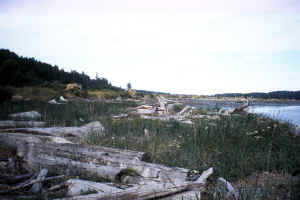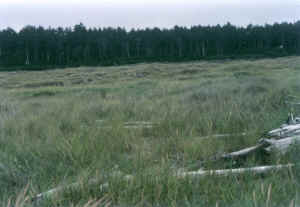No. 26. Coastal Dunes and Beaches
Christopher B. Chappell, David H. Johnson, and Jimmy
Kagan
Geographic Distribution. This habitat occurs primarily along the outer
coast from southern Washington (Copalis Beach, Grays Harbor) south to
northern California. It occurs in all coastal Oregon counties, most abundantly
in Tillamook County and between Florence and Reedsport. In Washington it occurs
mainly in Grays Harbor and Pacific counties, and sporadically along the inland
marine waters of Clallam, San Juan, Skagit, and Island counties. It also occurs in British Columbia.
 Physical Setting. This habitat occurs primarily in wet, mild outer
coastal climates. Precipitation, almost always rain, typically averages >80
inches (203 cm) annually. Summers are relatively dry, but fog is common.
Elevation is at and very near sea level, only extending as high as the highest
dunes. Topography is mildly to strongly undulating in the form of mostly
north-south trending dune ridges and troughs. Soils, when present, are always
sandy and are underlain by deep deposits of sand, thereby creating edaphically
dry sites. Soils are also very poor in nutrients and organic matter. These
dunes, spits, and berms are derived from sand carried by longshore drift and
wind erosion. Dunes consist of several types that differ in their physical form,
including foredunes, transverse dunes, parabola dunes, and retention ridges
220. Outlier examples away from the outer coast in the northern Puget
Trough are small in extent, occur in a drier climate, and mainly occur in the
form of sand spits and berms as opposed to dunes. Physical Setting. This habitat occurs primarily in wet, mild outer
coastal climates. Precipitation, almost always rain, typically averages >80
inches (203 cm) annually. Summers are relatively dry, but fog is common.
Elevation is at and very near sea level, only extending as high as the highest
dunes. Topography is mildly to strongly undulating in the form of mostly
north-south trending dune ridges and troughs. Soils, when present, are always
sandy and are underlain by deep deposits of sand, thereby creating edaphically
dry sites. Soils are also very poor in nutrients and organic matter. These
dunes, spits, and berms are derived from sand carried by longshore drift and
wind erosion. Dunes consist of several types that differ in their physical form,
including foredunes, transverse dunes, parabola dunes, and retention ridges
220. Outlier examples away from the outer coast in the northern Puget
Trough are small in extent, occur in a drier climate, and mainly occur in the
form of sand spits and berms as opposed to dunes.
 Landscape Setting. This habitat occurs in a natural mosaic with Westside
Lowland Conifer-Hardwood Forest, Westside Riparian-Wetlands, and Herbaceous
Wetlands. Forests adjacent to this habitat are found on stabilized dunes and are
dominated by shore pine (Pinus contorta var. contorta) and Sitka spruce (Picea
sitchensis). Wooded, shrubby, and herbaceous
wetlands occur in seasonally flooded deflation plains or dune troughs. Hookerís
willow (Salix hookeriana) and slough sedge (Carex obnupta) are the
2 most characteristic species in these wetlands. This habitat is in a mosaic
with the Urban habitat, as coastal areas have been developed extensively for
tourism and low-density residential uses. Recreation is a major land use and
includes the use of off-road vehicles. In southern Washington and northern
Oregon, the wetlands are often converted to agriculture for cranberries. Landscape Setting. This habitat occurs in a natural mosaic with Westside
Lowland Conifer-Hardwood Forest, Westside Riparian-Wetlands, and Herbaceous
Wetlands. Forests adjacent to this habitat are found on stabilized dunes and are
dominated by shore pine (Pinus contorta var. contorta) and Sitka spruce (Picea
sitchensis). Wooded, shrubby, and herbaceous
wetlands occur in seasonally flooded deflation plains or dune troughs. Hookerís
willow (Salix hookeriana) and slough sedge (Carex obnupta) are the
2 most characteristic species in these wetlands. This habitat is in a mosaic
with the Urban habitat, as coastal areas have been developed extensively for
tourism and low-density residential uses. Recreation is a major land use and
includes the use of off-road vehicles. In southern Washington and northern
Oregon, the wetlands are often converted to agriculture for cranberries.
Structure. This habitat consists of a variable mosaic of structures
ranging from open sand with sparse herbaceous vegetation to dense shrublands.
Trees are typically absent but may be scattered. Unstabilized sand may have very
little vegetation or open short grasslands or forb-dominated communities, though
these are now relatively uncommon and local. Medium-tall grasslands, typically
closed, are a major component in the current landscape. Tall broadleaf evergreen
shrubs, typically dense, are also a significant component of the mosaic.
 Composition. Where they are vegetated, unstabilized dunes
or strand are typically
dominated or co-dominated by American dunegrass (Leymus mollis), dune
bluegrass (Poa macrantha), or Chinook lupine (Lupinus littoralis).
Red fescue (Festuca rubra) was once a major dominant on more stabilized
dunes but has been largely replaced by European beachgrass (Ammophila
arenaria), an introduced species that is now the most common dune grass.
Many forb species are largely confined to herb-dominated dunes or strand and may take on
local importance. Composition. Where they are vegetated, unstabilized dunes
or strand are typically
dominated or co-dominated by American dunegrass (Leymus mollis), dune
bluegrass (Poa macrantha), or Chinook lupine (Lupinus littoralis).
Red fescue (Festuca rubra) was once a major dominant on more stabilized
dunes but has been largely replaced by European beachgrass (Ammophila
arenaria), an introduced species that is now the most common dune grass.
Many forb species are largely confined to herb-dominated dunes or strand and may take on
local importance.
Tall shrublands are dominated primarily by salal (Gaultheria shallon)
and evergreen huckleberry (Vaccinium ovatum), but may also have prominent
amounts of hairy manzanita (Arctostaphylos columbiana), kinnikinnick
(Arctostaphylos uva-ursi), bush lupine (Lupinus arboreus), or
California wax-myrtle (Myrica califorica). Coyotebrush (Baccharis
pilularis) is abundant in southern Oregon. Both Scotís broom (Cytisus
scoparius) and gorse (Ulex europaeus) are exotic shrubs that dominate
disturbed areas. Scattered trees are mainly shore pine (Pinus contorta
var. contorta), or, less commonly, Sitka spruce (Picea sitchensis).
 Other Classifications and Key References. Franklin and Dryness 88
called this habitat sand dune and strand communities. The Oregon Gap II Project 126
and Oregon Vegetation Landscape-Level Cover Types 127 would
crosswalk with coastal dunes habitat. This habitat is not well represented by
the Washington Gap project: it takes up small percentages of several types in
the Sitka spruce zone, including conifer forest, hardwood forests, and
coastline, sandy beaches, and rocky islands. Other references describe this
habitat 8, 42, 137, 219, 220. Other Classifications and Key References. Franklin and Dryness 88
called this habitat sand dune and strand communities. The Oregon Gap II Project 126
and Oregon Vegetation Landscape-Level Cover Types 127 would
crosswalk with coastal dunes habitat. This habitat is not well represented by
the Washington Gap project: it takes up small percentages of several types in
the Sitka spruce zone, including conifer forest, hardwood forests, and
coastline, sandy beaches, and rocky islands. Other references describe this
habitat 8, 42, 137, 219, 220.
Natural Disturbance Regime. Erosion and deposition of sand are the
primary natural processes controlling this habitat. Sand is deposited initially
on beaches, and then moved into dunes through wind erosion 220. Wind
also maintains unstabilized dune areas. Major winter storm events may result in
blowouts that create holes in existing stabilized or unstabilized dunes,
creating new areas of sand deposition.
Succession and Stand Dynamics. The different structural variants of the
mosaic within this habitat are primarily stages in succession from freshly
deposited sand to completely stabilized shrub-dominated dunes 220.
Unstabilized sand, such as foredunes with little European beachgrass, has the
most open and herbaceous vegetation. Closing of the vegetation typically results
in stabilization of the sand. Recently stabilized dunes are now primarily
dominated by European beachgrass. Given more time without a major disturbance,
shrubs and/or trees colonize the grasslands. Shrublands are sometimes an
intermediate stage in succession toward forests. Pine woodlands are another very
common intermediate stage. Eventually, pine woodlands are colonized by Sitka
spruce or Douglas-fir and become mixed pine-spruce or pine-Douglas-fir forests.
Any one of these stages can be set back to sand by a blowout or reburial by
dunes, and a cyclic successional sequence is common in many areas 42.
 Effects of Management and Anthropogenic Impacts. European beachgrass has
been extensively planted for stabilization purposes and has also spread widely
on its own. Unstabilized sand is now a relatively rare condition primarily
because of the introduction of this species. The physical forms of dunes also
have been altered by beachgrass 55, 56. Forests are probably forming
at a greater rate than they did in the past because of increased stabilization.
Exotic species, especially sweet vernalgrass (Anthoxanthum odoratum) and
common velvetgrass (Holcus lanatus), are now a nearly ubiquitous
component of herb-dominated communities. The spread of such species may be
related to past livestock grazing in many areas 42. Scotís broom
and gorse are aggressive exotic shrub invaders that were planted for
stabilization and have spread widely. Since both are legumes, they result in
major nitrogen increases where they establish. Off-road vehicle use has resulted
in complete destruction of native herbaceous communities in some areas 220.
Trampling is a potential threat in herbaceous communities 42, 220. Effects of Management and Anthropogenic Impacts. European beachgrass has
been extensively planted for stabilization purposes and has also spread widely
on its own. Unstabilized sand is now a relatively rare condition primarily
because of the introduction of this species. The physical forms of dunes also
have been altered by beachgrass 55, 56. Forests are probably forming
at a greater rate than they did in the past because of increased stabilization.
Exotic species, especially sweet vernalgrass (Anthoxanthum odoratum) and
common velvetgrass (Holcus lanatus), are now a nearly ubiquitous
component of herb-dominated communities. The spread of such species may be
related to past livestock grazing in many areas 42. Scotís broom
and gorse are aggressive exotic shrub invaders that were planted for
stabilization and have spread widely. Since both are legumes, they result in
major nitrogen increases where they establish. Off-road vehicle use has resulted
in complete destruction of native herbaceous communities in some areas 220.
Trampling is a potential threat in herbaceous communities 42, 220.
Status and Trends. This habitat covers a relatively limited area and
major expanses of it have been converted to other uses. The vast majority of
herbaceous vegetation that remains is in poor condition, being dominated by
exotic species. Current trends are probably decreasing in both extent and
condition because of continued development in coastal areas and continuing
expansion of exotic species into the few remaining native-dominated areas. Six
of 11 plant associations currently listed in the National Vegetation
Classification representing this habitat are considered imperiled or critically
imperiled 10.
[ Top ]
[ Literature Citations ]
[ Wildlife-Habitat Types - Table 1 ]
|